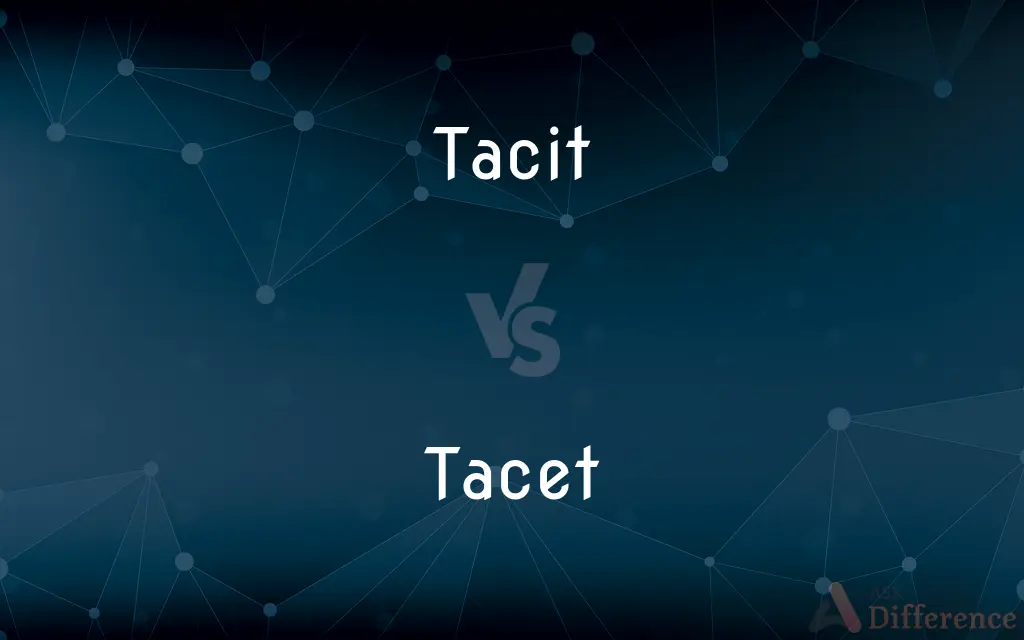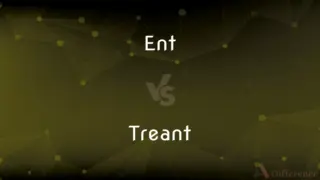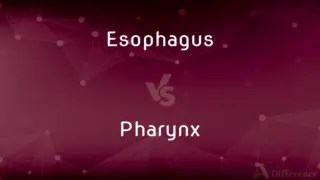Tacit vs. Tacet — What's the Difference?
Edited by Tayyaba Rehman — By Maham Liaqat — Updated on April 7, 2024
Tacit implies unspoken understanding or agreement, whereas tacet instructs silence in music.

Difference Between Tacit and Tacet
Table of Contents
ADVERTISEMENT
Key Differences
Tacit knowledge or consent is understood or implied without being stated openly; it relies on context and shared understanding among people. For instance, a nod can be a tacit agreement to a proposed idea. On the other hand, tacet is a term used in musical scores to indicate that a particular instrument or voice does not participate in a section of the composition, signaling the musician to remain silent during the indicated passage. This distinction highlights how tacit involves an active but unspoken engagement, while tacet demands inactivity or silence.
While tacit communication is pivotal in daily interactions, fostering implicit agreements and understandings without the need for explicit statements, tacet serves a specific function in the realm of music performance. Tacet sections contribute to the overall texture and dynamics of a piece, allowing other instruments or voices to come to the forefront. This comparison underscores the contextual specificity of tacet, in contrast to the broader applicability of tacit understandings in various forms of social interaction.
Tacit knowledge is also a critical concept in organizational and psychological contexts, referring to the skills or understandings individuals possess that are difficult to articulate or transfer through verbal instruction. In contrast, tacet, by instructing silence, plays a crucial role in the structural and dynamic aspects of musical compositions, emphasizing the importance of absence or rest in the auditory experience. The contrast here illustrates the depth and complexity of tacit knowledge versus the clear, directive nature of tacet.
In practical terms, tacit agreements or understandings often facilitate smoother interpersonal and group dynamics, as they rely on shared norms and expectations without necessitating formal acknowledgment. Conversely, tacet instructions ensure clarity and coordination in musical performances, where the timing and presence of silence are as meticulously planned as the notes themselves. This highlights how both concepts, though distinct, play essential roles in facilitating harmony, be it in social settings or musical compositions.
While tacit entails a broad spectrum of unexpressed but understood agreements or knowledge across various domains of human interaction, tacet is confined to the specific context of musical notation. This difference emphasizes the specialized use of tacet in guiding musicians, compared to the ubiquitous nature of tacit understandings in shaping human behavior and communication.
ADVERTISEMENT
Comparison Chart
Definition
Understood or implied without being expressed
Instructs musicians to be silent during a part of the score
Context
General, applies to knowledge or agreement
Musical notation
Communication
Non-verbal, implied
Explicit instruction in written form
Role
Facilitates implicit understanding and agreements
Indicates periods of silence in music
Application
Broad, in everyday interactions and organizational settings
Specific to musical compositions
Compare with Definitions
Tacit
Implied by actions or statements.
His tacit admission of guilt was clear from his avoidance of the topic.
Tacet
A directive for musicians to remain silent.
The tacet instruction allowed for a dramatic pause in the performance.
Tacit
Understood without being openly expressed.
The tacit approval of her proposal was evident in their smiles.
Tacet
Specific to musical notation.
She checked the score for any tacet sections to prepare.
Tacit
Existing without vocalization.
There was a tacit agreement among them to never discuss the event.
Tacet
Used in music to signal no participation.
For this movement, the brass section will tacet.
Tacit
Inferred from actions rather than words.
Their tacit understanding enabled them to work seamlessly together.
Tacet
Denotes a rest period for an instrument or voice.
The piano tacet during the flute solo creates a beautiful contrast.
Tacit
Not spoken but understood.
In their culture, respect for elders is a tacit expectation.
Tacet
Indicates silence in a musical part.
The score marked 'tacet' for the drums during the second verse.
Tacit
Not spoken
Indicated tacit approval by smiling and winking.
Tacet
Tacet is Latin which translates literally into English as "(it) is silent" (pronounced: , , or ). It is a musical term to indicate that an instrument or voice does not sound, also known as a rest.
Tacit
Implied by or inferred from actions or statements
Management has given its tacit approval to the plan.
Tacet
Be silent. Used chiefly as a direction.
Tacit
(Archaic) Not speaking; silent.
Tacet
(music) An instruction indicating silence on the part of the performers of a piece.
Tacit
Implied, but not made explicit, especially through silence.
Tacit consent'' : consent by silence, or by not raising an objection
Tacet
It is silent; - a direction for a vocal or instrumental part to be silent during a whole movement.
Tacit
(logic) Not derived from formal principles of reasoning; based on induction rather than deduction.
Tacit
Done or made in silence; implied, but not expressed; silent; as, tacit consent is consent by silence, or by not interposing an objection.
The tacit and secret theft of abusing our brother in civil contracts.
Tacit
Indicated by necessary connotation though not expressed directly;
Gave silent consent
A tacit agreement
The understood provisos of a custody agreement
Common Curiosities
Can tacit knowledge be easily shared?
Tacit knowledge is challenging to articulate and share because it is understood internally and often relies on personal experience.
What does tacit mean?
Tacit means understood or implied without being explicitly stated.
Does tacet affect the dynamics of a musical piece?
Yes, tacet sections can dramatically affect the dynamics and texture of a piece by introducing contrast through silence.
Can tacit consent be problematic?
Tacit consent can lead to misunderstandings or assumptions, as it relies on unspoken agreements that may not be clearly understood by all parties.
Is there a visual indicator for tacet in musical scores?
Yes, the term "tacet" is written in the part of the score where the musician is instructed to remain silent.
How does tacet contribute to the emotional impact of a piece?
Tacet can enhance the emotional impact by creating moments of anticipation or highlighting the return of sound after silence.
How is tacit knowledge acquired?
Tacit knowledge is acquired through personal experience, observation, and social interaction, often without direct instruction.
What is the purpose of tacet in music?
Tacet is used to indicate that a musician should not play for a certain section of a piece, creating intentional silence.
How do musicians know when to observe tacet?
Musicians refer to the score, where tacet is clearly marked for specific instruments or voices, indicating when they should be silent.
Is tacit agreement legally binding?
While tacit agreements can be binding, proving their existence and terms can be difficult due to their implicit nature.
Can tacet apply to all instruments in an orchestra?
Yes, tacet can apply to any instrument or voice part within a musical composition when silence from that part is desired.
Can tacit agreements be considered a form of non-verbal communication?
Yes, tacit agreements are a form of non-verbal communication, relying on implicit understanding rather than explicit words.
How does tacit knowledge differ from explicit knowledge?
Tacit knowledge is internalized and often difficult to articulate, whereas explicit knowledge can be easily communicated and documented.
Is tacit understanding sufficient in professional settings?
While tacit understanding can facilitate smooth interactions, explicit communication is often necessary to ensure clarity and avoid misunderstandings in professional contexts.
What role does tacet play in solo performances?
In solo performances, tacet instructions may be irrelevant unless they pertain to accompanying instruments or recorded tracks.
Share Your Discovery

Previous Comparison
Ent vs. Treant
Next Comparison
Esophagus vs. PharynxAuthor Spotlight
Written by
Maham LiaqatEdited by
Tayyaba RehmanTayyaba Rehman is a distinguished writer, currently serving as a primary contributor to askdifference.com. As a researcher in semantics and etymology, Tayyaba's passion for the complexity of languages and their distinctions has found a perfect home on the platform. Tayyaba delves into the intricacies of language, distinguishing between commonly confused words and phrases, thereby providing clarity for readers worldwide.














































